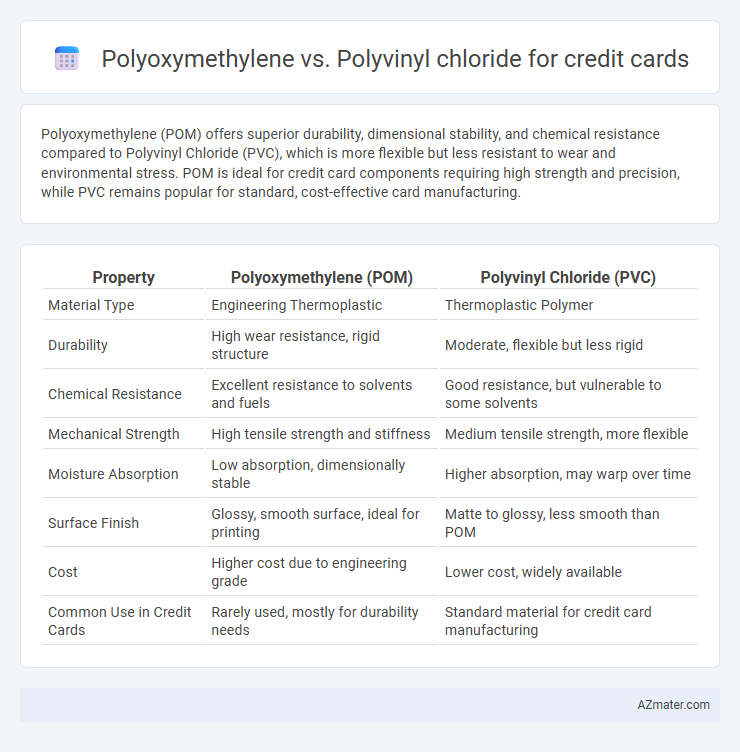Polyoxymethylene (POM) offers superior durability, dimensional stability, and chemical resistance compared to Polyvinyl Chloride (PVC), which is more flexible but less resistant to wear and environmental stress. POM is ideal for credit card components requiring high strength and precision, while PVC remains popular for standard, cost-effective card manufacturing.
Table of Comparison
| Property | Polyoxymethylene (POM) | Polyvinyl Chloride (PVC) |
|---|---|---|
| Material Type | Engineering Thermoplastic | Thermoplastic Polymer |
| Durability | High wear resistance, rigid structure | Moderate, flexible but less rigid |
| Chemical Resistance | Excellent resistance to solvents and fuels | Good resistance, but vulnerable to some solvents |
| Mechanical Strength | High tensile strength and stiffness | Medium tensile strength, more flexible |
| Moisture Absorption | Low absorption, dimensionally stable | Higher absorption, may warp over time |
| Surface Finish | Glossy, smooth surface, ideal for printing | Matte to glossy, less smooth than POM |
| Cost | Higher cost due to engineering grade | Lower cost, widely available |
| Common Use in Credit Cards | Rarely used, mostly for durability needs | Standard material for credit card manufacturing |
Introduction to Polyoxymethylene and Polyvinyl Chloride
Polyoxymethylene (POM) is a high-performance engineering thermoplastic known for its exceptional stiffness, low friction, and excellent dimensional stability, making it suitable for the structural components of credit cards. Polyvinyl chloride (PVC), a widely used thermoplastic polymer, offers flexibility, durability, and ease of printing, which is why it has been the traditional choice for credit card manufacturing. Comparing POM and PVC reveals differences in mechanical properties and surface finish that influence durability and user experience in credit card applications.
Material Properties Comparison: POM vs PVC
Polyoxymethylene (POM) offers superior mechanical strength, stiffness, and dimensional stability compared to Polyvinyl Chloride (PVC), providing enhanced durability for credit card applications. POM exhibits excellent resistance to wear, chemicals, and moisture, ensuring long-lasting performance and a premium tactile feel. In contrast, PVC is more flexible and cost-effective but prone to surface scratching and deformation, making POM the preferred choice for high-quality, durable credit cards.
Durability and Wear Resistance for Credit Cards
Polyoxymethylene (POM) offers superior durability and wear resistance compared to Polyvinyl Chloride (PVC) for credit card manufacturing. POM's high tensile strength and excellent abrasion resistance ensure longer-lasting cards that withstand frequent handling and exposure to environmental factors. PVC, while cost-effective and widely used, tends to wear down faster, leading to surface scratches and color fading over time.
Flexibility and Handling Performance
Polyoxymethylene (POM) offers superior rigidity and dimensional stability compared to Polyvinyl Chloride (PVC), resulting in less flexibility but enhanced durability for credit card applications. PVC provides better flexibility and ease of handling, allowing for smoother lamination and embossing processes crucial for card personalization. The choice between POM and PVC directly impacts the balance between structural integrity and user-friendly handling in credit card manufacturing.
Environmental Impact and Sustainability
Polyoxymethylene (POM) offers superior recyclability and lower environmental toxicity compared to Polyvinyl Chloride (PVC), which releases harmful dioxins during production and disposal. PVC cards often pose significant environmental challenges due to their chlorine content and limited biodegradability, whereas POM's chemical stability contributes to a reduced carbon footprint. Choosing POM for credit cards enhances sustainability by facilitating recycling processes and minimizing harmful emissions throughout the product lifecycle.
Cost Analysis: POM vs PVC Manufacturing
Polyoxymethylene (POM) offers higher precision and durability in credit card manufacturing but comes with increased production costs compared to Polyvinyl Chloride (PVC). PVC remains the industry standard due to its lower raw material expenses and more established, cost-effective manufacturing processes. Cost analysis reveals PVC's advantage in large-scale production, while POM is favored for premium cards requiring enhanced strength and longevity despite higher initial investment.
Security Features and Data Protection
Polyoxymethylene (POM) offers superior durability and chemical resistance compared to Polyvinyl Chloride (PVC), enhancing the longevity of credit cards without compromising embedded security features like holograms and microprinting. The material's dimensional stability supports precise encoding of magnetic stripes and RFID chips, crucial for secure data transmission and fraud prevention. PVC, while cost-effective, is more prone to wear and tampering, which can lead to vulnerabilities in protecting sensitive cardholder information.
Printing Quality and Customization Options
Polyoxymethylene (POM) offers superior printing quality for credit cards due to its smooth, non-porous surface, enabling sharp and vibrant graphics ideal for high-resolution designs. Polyvinyl chloride (PVC), while widely used, tends to have a slightly less smooth finish, which may result in less precise print details, but its compatibility with a variety of printing technologies supports diverse customization options such as embossing and foil stamping. Customization on POM is typically limited compared to PVC, as PVC's softer texture allows more extensive modifications, including tactile features and embedded elements, enhancing both aesthetic appeal and security.
Regulatory Compliance for Card Materials
Polyoxymethylene (POM) exhibits superior regulatory compliance for credit card materials due to its non-toxic, BPA-free composition and adherence to REACH and RoHS standards, minimizing health and environmental risks. Polyvinyl chloride (PVC), while commonly used, faces increasing scrutiny because of hazardous additive use such as phthalates and heavy metals, complicating compliance with evolving EU and US regulations. Selecting POM ensures enhanced material safety and sustained compliance in the dynamic regulatory landscape of payment cards.
Future Trends in Credit Card Material Innovation
Polyoxymethylene (POM) offers superior durability and flexibility compared to Polyvinyl Chloride (PVC), making it a promising candidate for next-generation credit card materials. Innovations in POM incorporate enhanced environmental sustainability and recyclability, addressing growing consumer and regulatory demands for eco-friendly solutions. Future trends indicate a shift towards materials like POM that enable embedded smart chip integration and improved resistance to wear, supporting advancements in secure, long-lasting credit card technologies.

Infographic: Polyoxymethylene vs Polyvinyl chloride for Credit card
 azmater.com
azmater.com